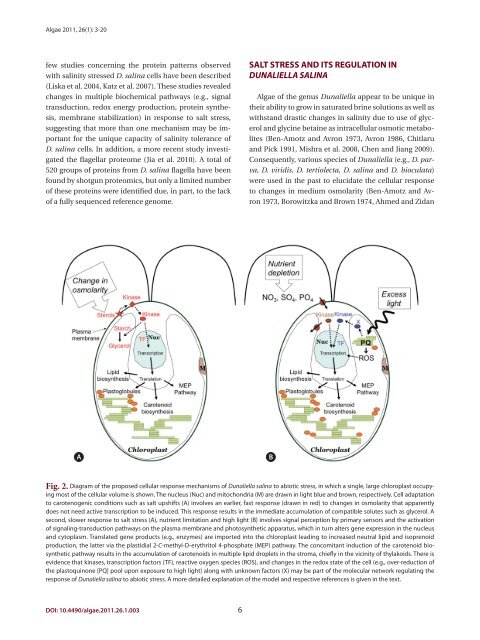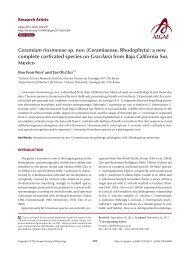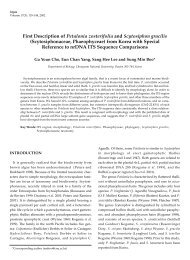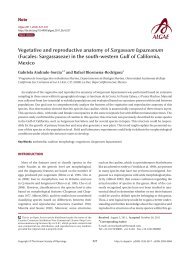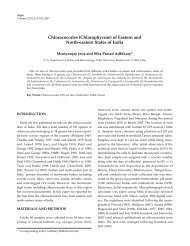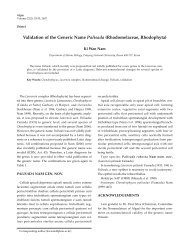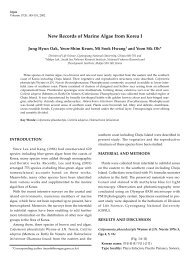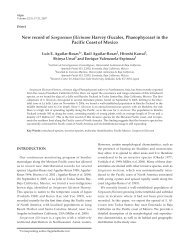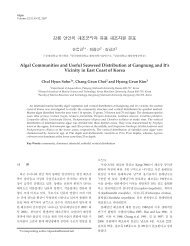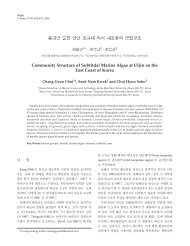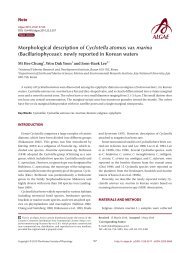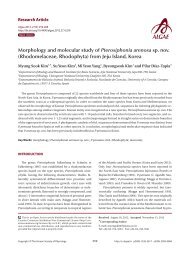The unicellular green alga Dunaliella salina Teod. as a model - Algae
The unicellular green alga Dunaliella salina Teod. as a model - Algae
The unicellular green alga Dunaliella salina Teod. as a model - Algae
Create successful ePaper yourself
Turn your PDF publications into a flip-book with our unique Google optimized e-Paper software.
<strong>Algae</strong> 2011, 26(1): 3-20<br />
few studies concerning the protein patterns observed<br />
with salinity stressed D. <strong>salina</strong> cells have been described<br />
(Liska et al. 2004, Katz et al. 2007). <strong>The</strong>se studies revealed<br />
changes in multiple biochemical pathways (e.g., signal<br />
transduction, redox energy production, protein synthesis,<br />
membrane stabilization) in response to salt stress,<br />
suggesting that more than one mechanism may be important<br />
for the unique capacity of salinity tolerance of<br />
D. <strong>salina</strong> cells. In addition, a more recent study investigated<br />
the flagellar proteome (Jia et al. 2010). A total of<br />
520 groups of proteins from D. <strong>salina</strong> flagella have been<br />
found by shotgun proteomics, but only a limited number<br />
of these proteins were identified due, in part, to the lack<br />
of a fully sequenced reference genome.<br />
A B<br />
DOI: 10.4490/<strong>alga</strong>e.2011.26.1.003 6<br />
SALT STRESS AND ITS REGULATION IN<br />
DUNALIELLA SALINA<br />
<strong>Algae</strong> of the genus <strong>Dunaliella</strong> appear to be unique in<br />
their ability to grow in saturated brine solutions <strong>as</strong> well <strong>as</strong><br />
withstand dr<strong>as</strong>tic changes in salinity due to use of glycerol<br />
and glycine betaine <strong>as</strong> intracellular osmotic metabolites<br />
(Ben-Amotz and Avron 1973, Avron 1986, Chitlaru<br />
and Pick 1991, Mishra et al. 2008, Chen and Jiang 2009).<br />
Consequently, various species of <strong>Dunaliella</strong> (e.g., D. parva,<br />
D. viridis, D. tertiolecta, D. <strong>salina</strong> and D. bioculata)<br />
were used in the p<strong>as</strong>t to elucidate the cellular response<br />
to changes in medium osmolarity (Ben-Amotz and Avron<br />
1973, Borowitzka and Brown 1974, Ahmed and Zidan<br />
Fig. 2. Diagram of the proposed cellular response mechanisms of <strong>Dunaliella</strong> <strong>salina</strong> to abiotic stress, in which a single, large chloropl<strong>as</strong>t occupying<br />
most of the cellular volume is shown. <strong>The</strong> nucleus (Nuc) and mitochondria (M) are drawn in light blue and brown, respectively. Cell adaptation<br />
to carotenogenic conditions such <strong>as</strong> salt upshifts (A) involves an earlier, f<strong>as</strong>t response (drawn in red) to changes in osmolarity that apparently<br />
does not need active transcription to be induced. This response results in the immediate accumulation of compatible solutes such <strong>as</strong> glycerol. A<br />
second, slower response to salt stress (A), nutrient limitation and high light (B) involves signal perception by primary sensors and the activation<br />
of signaling-transduction pathways on the pl<strong>as</strong>ma membrane and photosynthetic apparatus, which in turn alters gene expression in the nucleus<br />
and cytopl<strong>as</strong>m. Translated gene products (e.g., enzymes) are imported into the chloropl<strong>as</strong>t leading to incre<strong>as</strong>ed neutral lipid and isoprenoid<br />
production, the latter via the pl<strong>as</strong>tidial 2-C-methyl-D-erythritol 4-phosphate (MEP) pathway. <strong>The</strong> concomitant induction of the carotenoid biosynthetic<br />
pathway results in the accumulation of carotenoids in multiple lipid droplets in the stroma, chiefly in the vicinity of thylakoids. <strong>The</strong>re is<br />
evidence that kin<strong>as</strong>es, transcription factors (TF), reactive oxygen species (ROS), and changes in the redox state of the cell (e.g., over-reduction of<br />
the pl<strong>as</strong>toquinone [PQ] pool upon exposure to high light) along with unknown factors (X) may be part of the molecular network regulating the<br />
response of <strong>Dunaliella</strong> <strong>salina</strong> to abiotic stress. A more detailed explanation of the <strong>model</strong> and respective references is given in the text.


